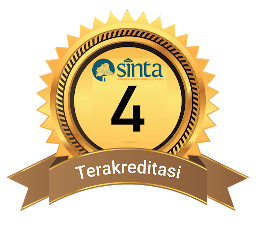Perception of Chemistry Teachers and Students of Class XI MIPA SMAN 1 And SMAN 2 Labuapi to The Work Sheet Students Contained In Ethnosains on Coloid Stainless Materials
DOI:
10.29303/cep.v7i1.5754Published:
2024-05-31Issue:
Vol. 7 No. 1 (2024): Edisi Mei 2024Keywords:
Perception, Ethnoscience, LKPD, colloidArticles
Downloads
How to Cite
Abstract
This study aims to describe the perceptions of teachers and students of class XI MIPA towards ethno-science-laden worksheets on the subject matter of colloids, This research is a descriptive research with a quantitative approach. The research population was chemistry teachers and students of class The sampling method was obtained using a saturated sampling technique. Teacher perception data is reviewed from 4 aspects, namely technique. Teacher perception data is reviewed from 4 aspects, namely technical, content, construct and ethnoscience, while student perception data is reviewed from 2 factors, namely internal factors and external factors. Data on teacher and students perceptions of ethnosciensce laden LKPD was collected using a closed questionnaire with a Likert scale. The descriptive statisticalanalysis technique used is in the form of the research show that teachers perceptions of all aspects in very good criteria with an average for technical aspects, construct content, ethnoscience of 91% , 83%, 87%, and 86%, while students perceptions of all factors are in good criteria with averages. Average on internal factors 82%, 82%, 81%, while external factors 83%, and 84%. Based on these results, it was concluded that the ethnoscience-laden LKPD which integrated jeleng oil into the subject matter of colloids was suitable for use in the learning process.
References
Andayani, Yayuk, Yunita Arian Sani Anwar & Safrizal Hadi Saputra. 2021. Pendekatan Etnosains dalam Pelajaran Kimia untuk Pembentukan Karakter Siswa: Tanggapan Guru Kimia di NTB”. J. MIPA. 16 (1) :42.
Ariani, D., & Meutiawati I. (2020). Pengembangan Lembar Kerja Peserta Didik (LKPD) Berbasis Discovery Learning pada Materikalor di SMP. Jurnal Phi: Jurnal pendidikan Fisika dan Fisika Terapan, 1 (3), 13-19.
Firdaus, M., & Wilujeng, I. (2018). Pengembangan LKPD Inkuiri Terbimbing untuk Meningkatkan Keterampilan Berpikir Kritis dan Hasil Belajar Peserta Didik. Jurnal Inovasi Pendidikan IPA, 4(1), 26-40.
Hadi, Wiwin Puspita 2017. “ Kajian Etnosains Madura dalam Proses Produksi Garam sebagai Media Pembelajaran IPA Terpadu”. Jurnal Ilmiah Rekayasa. 10 (2), 79-86
Hikmawati, Suastra, I., & Pujani, N. (2020). Local Wisdom is Lombok Island with The Potential of Ethnoscience for the Development of Learning Models in Junior High School. Journal of Physics: Conference Series, 1816(1), 1-12.
Idrus, Y., Yayuk Andayani & Rahmawati, 2020. “ Persepsi Siswa Kelas XI MIPA SMA/MA Se-Kota Praya Terhadap Lembar Kerja Peserta Didik Bermuatan Etnosains Pada Materi Pokok Koloid”. Chemistry Education Practice. 3 (2):2.
Indrawati, M., & Qosyim, A. (2017). Keefektifan Lembar Kerja Siswa (LKS) Berbasis Etnosains pada Materi Bioteknologi untu Melatih Keterampilan Proses Sains Siswa Kelas IX. E-journal UNESA, 5(2), 152-158.
Khasanah, B. A., & Fadil, A. (2018). Pengembangan LKPD Geometri Transformasi dengan Motif Tapis lampung. Jurnal Edumart, 4(2), 59-64.
Khoiri, A., & Sunarno, W. (2018). Pendekatan Etnosains dalam Tinjauan Filsafat. SPEKTRA: Jurnal Kajian Pendidikan Sains, 4(2), 96.
Lestari, Linda Titi., Eko Setyadi Kurniawan & Siska Desi Fatmawati, 2019. “ Pengembangan Lembar Kegiatan Peserta Didik Berbasis Thinking Actively in Social Context (TASC) untuk Meningkatkan Kemampuan Mencinpta Pada Peserta Didik SMA”.
Nureflia, Wenni. 2018. “ Pengembangan Lembar Kegiatan Siswa Berbasis Etnosains yang Berkarakter pada Materi Taksonomi Tumbuhan untuk Siswa SMA “. Jurnal Edu- Sains. 7 (1):34-42.
Novitasari, L., Agustina, P. A., Sukesti, R., Nazri, M. F., & Handhika, J. (2017). Fisika, Etnosains, Kearifan Lokal dalam Pembelajaran Sains. E-journal Unipma, 81-88.
Purwanto, Ngalim. 2013. Prinsip-prinsip dan Teknik Evaluasi Pengajaran. Bandung: Remaja Rosdakarya.
Pertiwi, W. J., Solfarina, & Langitasari, I. (2021). Pengembangan Lembar Kerja Peserta Didik (LKPD) Berbasis Etnosains Konsep Elektrolit dan Nonelektrolit. Jurnal Inovasi Pendidikan, 15(1), 2717-2730.
Sugiyono, 2016. Metode Penelitian Kuantitatif, Kualitatif dan R&D. Bandung: Alfabeta.
Sumarni, Woro. 2018. Etnosains dalam Pembelajaran Kimia: Prinsip, Pengembangan dan Implementasinya. Semarang: Unnes Press.
Author Biographies
Lisa Ariana, Universitas Mataram
Yayuk Andayani, Program Studi Pendidikan Kimia, Universitas Mataram. Mataram, Indonesia
Rahmawati Rahmawati, Program Studi Pendidikan Kimia, Universitas Mataram. Mataram, Indonesia
License
Copyright (c) 2024 Lisa Ariana, Yayuk Andayani, Rahmawati Rahmawati

This work is licensed under a Creative Commons Attribution-ShareAlike 4.0 International License.
Authors who publish with Chemistry Education Practice agree to the following terms:
- Authors retain copyright and grant the journal right of first publication with the work simultaneously licensed under a Creative Commons Attribution License 4.0 International License (CC-BY-SA License). This license allows authors to use all articles, data sets, graphics, and appendices in data mining applications, search engines, web sites, blogs, and other platforms by providing an appropriate reference. The journal allows the author(s) to hold the copyright without restrictions and will retain publishing rights without restrictions.
- Authors are able to enter into separate, additional contractual arrangements for the non-exclusive distribution of the journal's published version of the work (e.g., post it to an institutional repository or publish it in a book), with an acknowledgement of its initial publication in Chemistry Education Practice.
- Authors are permitted and encouraged to post their work online (e.g., in institutional repositories or on their website) prior to and during the submission process, as it can lead to productive exchanges, as well as earlier and greater citation of published work (See The Effect of Open Access).






